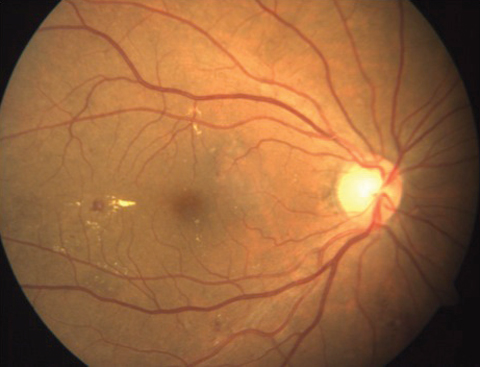 |
| Teleretinal screening is an effective approach to DR screening not only for its accuracy in detecting disease but also for improving screening compliance in a cost-effective manner. This approach was not, however, as effective in detecting DME. Photo: Thomas A. Wong, OD. Click image to enlarge. |
The American Academy of Ophthalmology periodically conducts literature reviews on emerging technologies and gives its expert opinion in a position paper—called an Ophthalmic Technology Assessment—on the current and future role of newer tools and techniques in eyecare. The organization’s latest one, issued last week in the Ophthalmology journal, looks at the effectiveness of conventional teleretinal screening in detecting diabetic retinopathy (DR) and diabetic macular edema (DME). The authors found that teleretinal screening is indeed effective in detecting DR and is preferred by patients over traditional screenings.
In this context, the specific implementation of telehealth screening “uses fundus photographs, often captured in a primary care setting, that are evaluated remotely by trained graders. Based on the interpretation, appropriate care interventions are recommended,” the paper explains. These photos may be mydriatic or nonmydriatic, depending on the specific program. Although the gold standard for fundus assessment in diabetes patients remains the ETDRS 30°, seven-standard field photography protocol, telehealth efforts at the level of primary care are typically less rigorous, the paper explains, so it’s important to understand how these more practical efforts compare.
The authors identified data in the PubMed database between 2006 and 2023 on the following elements related to teleretinal screening effectiveness:
- the accuracy of teleretinal screening in detecting DR or DME compared with traditional ophthalmic screening with dilated fundus examination or seven-standard field ETDRS photography
- the impact of teleretinal screening on DR screening compliance rates or other patient behaviors
- the cost-effectiveness and patient satisfaction of teleretinal screening compared with traditional DR screening
Eight level I studies, 14 level II studies and two level III studies were identified in total, with most demonstrating acceptable accuracy compared with a traditional dilated examination or seven-standard field ETDRS fundus photography and indicated that telehealth methods may be used to complement traditional screening.
Teleretinal screening demonstrated acceptable sensitivity and good specificity in detecting DR, but was not as robust in detecting DME, although the number of studies evaluating DME specifically was limited. Two level I studies, five level II studies and one level III study supported that teleretinal screening had a positive impact on overall DR screening compliance, even increasing it by more than twofold in one study.
Although specific accuracy metrics varied between studies, a few general trends emerged, according to the authors.
“First, when disagreement in DR grading occurred between teleretinal screening images and the reference standard, the disparity often fell within one DR level and typically represented an overcall by teleretinal screening, which was preferred to an undercall in screening programs,” the authors explained in the Ophthalmic Technology Assessment. “Second, ungradable rates of teleretinal screening imaging may surpass 30% in certain programs and are improved with pupillary dilation. Although risk of acute angle closure is exceedingly low with pharmacologic mydriasis, the additional cost, time and patient dissatisfaction should be considered. Third, the accuracy of teleretinal screening in detecting and grading DR is better than that for DME. Fourth, the accuracy of teleretinal screening in detecting more advanced DR is better than that for less advanced DR, supporting the ability to use teleretinal screening as a screening tool supplemented by referrals for in-clinic examination if a certain threshold is met.”
Most published data support the premise that teleretinal screening improves screening rates among patients with DM presumably because of increased accessibility, improved convenience and decreased appointment wait times. These improved rates seem especially pronounced in areas that are rural or underserved, the authors noted.
“Additionally, some evidence suggests that patient education, which often is integrated into the teleretinal screening visits, may impact future likelihood to seek repeat DR screening positively,” the position paper explained. “Although not as well studied, it is possible that teleretinal screening may even have benefits on DM-related medical outcomes such as lowering glycated hemoglobin and cholesterol levels. One aspect of compliance that warrants further exploration involves the adherence rate for patients with positive teleretinal screening findings who are referred for an in-clinic examination. When reported, these rates were not as high as desired, with one program reporting a rate as low as 12%.”
Lastly, one of the most important findings was that while studies assessing cost-effectiveness and patient satisfaction were not graded formally, they generally showed that teleretinal screening was cost-effective and preferred by patients over traditional surveillance.
Weng CY, Maguire MG, Flaxel CJ, et al. Effectiveness of conventional digital fundus photography-based teleretinal screening for diabetic retinopathy and diabetic macular edema. Amer Aca Ophthalmol. February 9, 2024. [Epub ahead of print]. |


